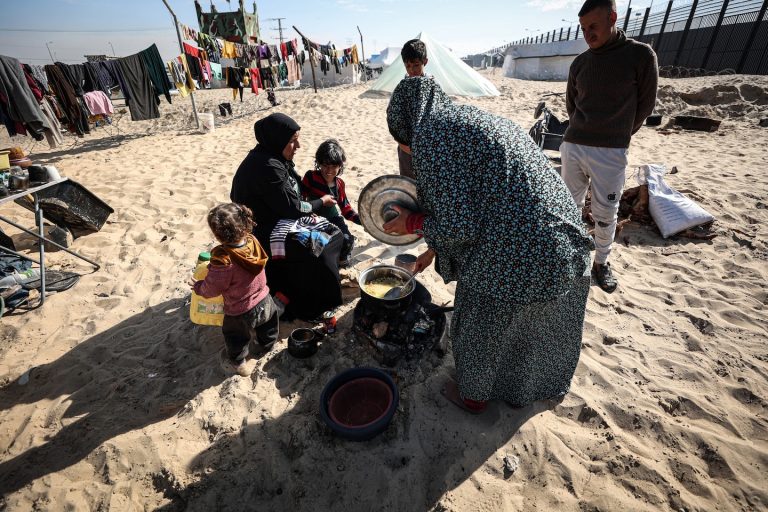“If the situation continues, you may see people dying [of hunger] “In the streets,” said Mohammed, who worked as a driver before the war. Like others in this story, he spoke on the condition that he be identified by his first name only, for fear of retaliation by Israeli forces.
The Washington Post spoke with six families across Gaza about their daily struggle to obtain food. 93% of the population there faces “crisis levels of hunger,” according to a report published in late December by an international consortium backed by the United Nations. More than half a million people – a quarter of the population of the besieged and bombed enclave – face “catastrophic hunger and starvation,” the report said.
“The scale and speed of this crisis are unprecedented in modern times,” World Food Program spokesman Steve Taravella said last month. “If current projections continue, we will reach famine by February.”
Israel rejected the report's findings.
“There is no famine in Gaza, period,” Colonel Elad Goren, who heads the Office for the Coordination of Government Activities in the Territories, the wing of the Israeli Defense Ministry that oversees Palestinian civilian affairs, told reporters on Monday.
There is no estimate of how many Palestinians in Gaza have died directly or indirectly from hunger: with the vast majority of the population displaced and the medical system largely destroyed, many deaths remain uncounted, or their causes undetermined. The few remaining hospitals usually record only deaths resulting from Israeli attacks.
More than 25,700 Palestinians, many of them women and children, were killed, and another 63,700 wounded in the Israeli war against Hamas, according to the Gaza Ministry of Health. The Israeli army says it has killed at least 9,000 militants. Thousands of Gazans are still missing, believed to be buried under rubble.
As the Israeli military shifts to what it says is a more targeted phase of the fighting – partly in response to international pressure over the war's staggering human toll – aid agencies are warning that the biggest long-term threats to Gaza's population are hunger, disease and winter exposure. cold.
Younger people are most at risk. Mohammed says his 7-month-old son suffers from dehydration and malnutrition. His hungry mother struggles to breastfeed.
Sabah Abu Ataya, 19 years old, was displaced three times while pregnant with her second child. She said that during the last three months of her pregnancy, she ate about once a day, usually something canned.
Wafa arrived early, on December 15, a baby girl weighing less than six pounds.
“Doctors attributed this to the malnutrition I was suffering from,” Abu Ataya told the newspaper on Wednesday.
The family fled fighting twice more in Lofa's first month. Abu Ataya said that on January 16, they arrived in a relatively safe area in Rafah in southern Gaza. But she said she could barely produce any milk. The baby is breastfed once or twice a day.
On Friday, Wafa's color turned blue. Abu Ataya frantically rushed to the medical center, which sent her to an overcrowded hospital, which in turn sent her to another hospital.
Wafaa was dead when they arrived. She was 35 days old.
“The girl died as a result of hunger and cold [still] “The war never ends,” her mother lamented.
Israel and Egypt imposed a siege on Gaza in 2007 after Hamas seized power. Even before the war, about 3 out of every 4 people in the Strip depended on the United Nations for food. After October 7, Israel imposed an almost complete blockade. Aid was allowed in again after lengthy negotiations, but the process remains slow and inefficient – about 150 trucks a day pass through the Egyptian Rafah and Israeli Kerem Shalom crossings after Israeli inspections, a decline from about 500 trucks a day before the war.
“If we want to prevent famine… we have to make sure that there is a significant increase in the humanitarian and commercial sector,” said Juliette Touma, of the United Nations Relief and Works Agency for Palestine Refugees.
The Israeli authorities accuse Hamas of stealing aid from civilians and say that humanitarian organizations exaggerate the threat of hunger.
“You can see pictures from the Palestinian media, not the ones published by the Israeli army, of the markets, not only in the south but also in the north, where there are vegetables, fruits and bread,” said Goren, of the Office for the Coordination of Government Activities in the Territories. “I think the reality speaks for itself.”
As aid increased, more food products, such as canned meat, tuna and cheese, became available. In some areas, flour prices stabilized and farmers began harvesting winter crops.
But high inflation means that few Palestinians can afford what is on sale. Conditions are worst in the north, which has been isolated by Israeli forces and largely beyond the reach of aid organisations.
Muhammad Abu Sharkh, Muhammad’s neighbor in Beit Lahia, waited in the same line for days for flour. Others he knew had gone north 'to the places where he was [Israeli] The army was hoping to get the canned goods he had left behind. He said some were killed. Others returned with food.
Before the war, the 39-year-old had a work permit in Israel. His family ate well. Now, he says, his six children have lost weight. Their rib cages stick out.
“I give them only one meal a day, usually at night, so they can sleep without crying,” he said.
Reem, a mother of three children in Gaza City, said she lost nearly 30 pounds. The price of flour rose.
“No fruits or vegetables,” she said. “Nothing with vitamins. Nothing with protein.”
Reem worked in the humanitarian sector before the war. She now says her family lives on dwindling supplies of rice. Sometimes they find subsidized biscuits from relief agencies.
When it's safe enough, her husband and children spend hours outside searching for supplies; She remains inside to care for her mother-in-law, who is unable to move and was injured in one of the raids. She worries constantly — about Israeli bombs and snipers, about the growing number of desperate Gazans raiding abandoned homes and aid convoys.
Mervat (51 years old), who was working in providing food in Gaza City, said that there are more food supplies in Rafah, where a million displaced people have taken refuge, but they are not distributed equally.
“We see aid coming, but to whom we do not know,” she said via WhatsApp from a camp where she lives with her relatives. “Even those who distribute aid, they give it to their friends. If you don't know anyone, you won't get anyone.”
Mervat goes twice a week to a UN-run school where she says she gets a few vegetables and potatoes. She is diabetic and has developed a kidney infection, likely due to dehydration and an untreated urinary tract infection. She eats once a day, if she eats at all.
Mervat is divorced and is used to hosting her adult children for meals in her own apartment, which is unusual for a single woman in Gaza. That home and that life are gone.
Close to the Egyptian border, Shahnaz Nofal's extended family of 50 people lives between two tents in the sand. Displaced three times, the mother of six children supplies her with a bottle of water and a packet of meat, tuna or cheese that she receives weekly from the United Nations.
On a good day, Novel, 38, can find and buy pasta, which she cooks over a fire made of nylon or scraps of paper.
She said: “I swear to God, we even crave a cup of tea, but the price of sugar is very high.”
One of the sons keeps asking for one egg from her. I promised to buy a whole carton for him when the war was over.
Harb reported from London and Ayoub from Rafah.

